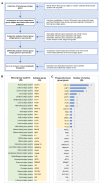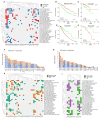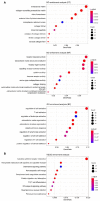A Comprehensive Prognostic Analysis of Tumor-Related Blood Group Antigens in Pan-Cancers Suggests That SEMA7A as a Novel Biomarker in Kidney Renal Clear Cell Carcinoma
- PMID: 35955933
- PMCID: PMC9369114
- DOI: 10.3390/ijms23158799
A Comprehensive Prognostic Analysis of Tumor-Related Blood Group Antigens in Pan-Cancers Suggests That SEMA7A as a Novel Biomarker in Kidney Renal Clear Cell Carcinoma
Abstract
Blood group antigen is a class of heritable antigenic substances present on the erythrocyte membrane. However, the role of blood group antigens in cancer prognosis is still largely unclear. In this study, we investigated the expression of 33 blood group antigen genes and their association with the prognosis of 30 types of cancers in 31,870 tumor tissue samples. Our results revealed that blood group antigens are abnormally expressed in a variety of cancers. The high expression of these antigen genes was mainly related to the activation of the epithelial-mesenchymal transition (EMT) pathway. High expression of seven antigen genes, i.e., FUT7, AQP1, P1, C4A, AQP3, KEL and DARC, were significantly associated with good OS (Overall Survival) in six types of cancers, while ten genes, i.e., AQP1, P1, C4A, AQP3, BSG, CD44, CD151, LU, FUT2, and SEMA7A, were associated with poor OS in three types of cancers. Kidney renal clear cell carcinoma (KIRC) is associated with the largest number (14 genes) of prognostic antigen genes, i.e., CD44, CD151, SEMA7A, FUT7, CR1, AQP1, GYPA, FUT3, FUT6, FUT1, SLC14A1, ERMAP, C4A, and B3GALT3. High expression of SEMA7A gene was significantly correlated with a poor prognosis of KIRC in this analysis but has not been reported previously. SEMA7A might be a putative biomarker for poor prognosis in KIRC. In conclusion, our analysis indicates that blood group antigens may play functional important roles in tumorigenesis, progression, and especially prognosis. These results provide data to support prognostic marker development and future clinical management.
Keywords: blood group antigen; cancer biomarker; pan-cancers; prognosis; tumor-associated antigens (TAAs).
Conflict of interest statement
The authors declare no conflict of interest.
Figures





Similar articles
-
LPAR2 correlated with different prognosis and immune cell infiltration in head and neck squamous cell carcinoma and kidney renal clear cell carcinoma.Hereditas. 2022 Mar 4;159(1):16. doi: 10.1186/s41065-022-00229-w. Hereditas. 2022. PMID: 35241179 Free PMC article.
-
Systematic analysis of alternative splicing signature unveils prognostic predictor for kidney renal clear cell carcinoma.J Cell Physiol. 2019 Dec;234(12):22753-22764. doi: 10.1002/jcp.28840. Epub 2019 May 29. J Cell Physiol. 2019. PMID: 31140607 Free PMC article.
-
Unique protein expression signatures of survival time in kidney renal clear cell carcinoma through a pan-cancer screening.BMC Genomics. 2017 Oct 3;18(Suppl 6):678. doi: 10.1186/s12864-017-4026-6. BMC Genomics. 2017. PMID: 28984208 Free PMC article.
-
Up-regulation expression and prognostic significance of Syntaxin4 in kidney renal clear cell carcinoma.BMC Cancer. 2021 Sep 6;21(1):992. doi: 10.1186/s12885-021-08736-1. BMC Cancer. 2021. PMID: 34482824 Free PMC article.
-
JMH blood group system: a review.Immunohematology. 2014;30(1):18-23. Immunohematology. 2014. PMID: 25238240 Review.
Cited by
-
Comprehensive Multi-Omics Analysis Identifies FUT1 as a Prognostic and Therapeutic Biomarker Across Pan-Cancer.Int J Med Sci. 2025 Feb 18;22(6):1313-1328. doi: 10.7150/ijms.108072. eCollection 2025. Int J Med Sci. 2025. PMID: 40084262 Free PMC article.
-
Association of Leukemia With ABO Blood Group Distribution and Discrepancy: A Review Article.Cureus. 2024 Mar 24;16(3):e56812. doi: 10.7759/cureus.56812. eCollection 2024 Mar. Cureus. 2024. PMID: 38654809 Free PMC article. Review.
-
Using Single-Cell RNA Sequencing and MicroRNA Targeting Data to Improve Colorectal Cancer Survival Prediction.Cells. 2023 Jan 5;12(2):228. doi: 10.3390/cells12020228. Cells. 2023. PMID: 36672162 Free PMC article.
-
Bimodal Genomic Approach Predicting Semaphorin 7A (SEMA7A) as Prognostic Biomarker in Adrenocortical Carcinoma.Cancers (Basel). 2025 Jun 21;17(13):2078. doi: 10.3390/cancers17132078. Cancers (Basel). 2025. PMID: 40647379 Free PMC article.
-
Identification of key genes and validation of key gene aquaporin 1 on Wilms' tumor metastasis.PeerJ. 2023 Oct 26;11:e16025. doi: 10.7717/peerj.16025. eCollection 2023. PeerJ. 2023. PMID: 37904849 Free PMC article.
References
-
- Yazawa S., Yokobori T., Ueta G., Ide M., Altan B., Thongprachum A., Nishimura T., Nakajima T., Kominato Y., Asao T., et al. Blood group substances as potential therapeutic agents for the prevention and treatment of infection with noroviruses proving novel binding patterns in human tissues. PLoS ONE. 2014;9:e89071. doi: 10.1371/journal.pone.0089071. - DOI - PMC - PubMed
MeSH terms
Substances
Grants and funding
LinkOut - more resources
Full Text Sources
Medical
Miscellaneous

